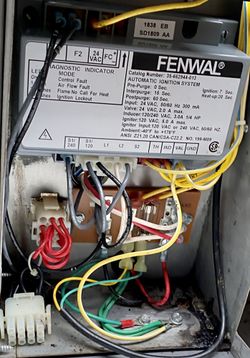(Created page with "=Heater Flame Sensing= Do you have a gas heater where the heater briefly ignites and you get s puff of heat and then shuts down? If so you have have a flame sensing problem....") |
|||
| Line 4: | Line 4: | ||
==The Fenwal box== | ==The Fenwal box== | ||
| − | + | [[File:Fenwal Flame Control Box.jpg|250px|thumb]] | |
Many gas heaters, including the Pentair MasterTemp and Jandy LXI, use an electronic control box manufactured by Fenwal to safely control the gas valve and flame. | Many gas heaters, including the Pentair MasterTemp and Jandy LXI, use an electronic control box manufactured by Fenwal to safely control the gas valve and flame. | ||
Revision as of 15:47, 17 February 2020
Heater Flame Sensing
Do you have a gas heater where the heater briefly ignites and you get s puff of heat and then shuts down? If so you have have a flame sensing problem. This article will describe what may be happening and ways to fix it.
The Fenwal box
Many gas heaters, including the Pentair MasterTemp and Jandy LXI, use an electronic control box manufactured by Fenwal to safely control the gas valve and flame.
The flame sense circuit is extremely reliable and sensitive.[1] Testing for the flame sense signal is easy if you have the right equipment but if not it's easier just to assume you have a good signal with a new module. If this assumption is correct your problem is one of the following (so long as you hear the flame ignite and briefly feel heat from the exhaust):
- Corrosion in the grounding circuit
- Broken or corroded current sensing wire
- Interference in the ground signal
You can fix these as follows:
- Take the blower flange bolt loose and strip a wire with a longish strip ( 1inch or so) then slide it into the gap between the flange and the flame tube, Connect this to the yellow ground wires that are ganged inside the control panel (usually next to the Fenwel). Then restart the unit and see if this works. This will ensure you have a good ground connection to the Fenwel which is required to measure the tiny signal.
- If you have had potential issues like this from a rat problem in the past then double-check the wire by replacing it.
- If the power supply wire insulation to the unit is compromised you can have leakage to the ground circuit that is very small so the unit will actually work but the ground has sufficient interference that it prevents the flame sense circuit inside the Fenwel from working. This can cause the Fenwel test pin readings to indicate a bad module but it isn't bad it's your power supply quality. To test this simply rig up a temporary parallel supply wire. I used a piece of romex wire I had laying around in the garage. Run it to a different breaker if possible. This is a test wire only, don't leave it in place due to the obvious hazard. If your unit runs this way then just re-pull new supply wires
Testing the Flame Sense Circuit
The best way to measure the flame sense current is with a true RMS meter.
If you don't have a RMS meter you can just test for voltage on the two test pins to confirm if you have flame sense. Voltage is an indirect indication but easier to do with typical DIY equipment. But it's still very difficult to measure unless you make up some pin wires to clip your voltmeter to. Or you can order some insulated micro clips for the test.
The reading should be 3-8 volts and this corresponds to the millionth's of an amp signal your flame sense signal should reading. If you try to check this be very careful since you can easily short the 24 vac circuit which can blow the transformer before the 2 amp fuse blows.
Fenwal Replacement
You may find that the easiest way to eliminate the Fenwal box from the problem is by replacing it. It is best to get a replacement box from an authorized Fenwal reseller. A member bought a replacement Fenwal box from a cheap eBay seller which did not work properly.


